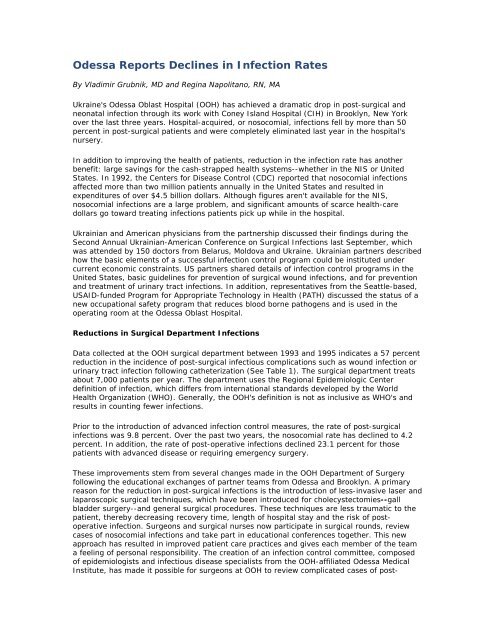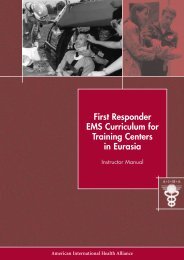Beyond Hospital Walls: Creating Healthy Communities - American ...
Beyond Hospital Walls: Creating Healthy Communities - American ...
Beyond Hospital Walls: Creating Healthy Communities - American ...
- No tags were found...
Create successful ePaper yourself
Turn your PDF publications into a flip-book with our unique Google optimized e-Paper software.
Odessa Reports Declines in Infection RatesBy Vladimir Grubnik, MD and Regina Napolitano, RN, MAUkraine's Odessa Oblast <strong>Hospital</strong> (OOH) has achieved a dramatic drop in post-surgical andneonatal infection through its work with Coney Island <strong>Hospital</strong> (CIH) in Brooklyn, New Yorkover the last three years. <strong>Hospital</strong>-acquired, or nosocomial, infections fell by more than 50percent in post-surgical patients and were completely eliminated last year in the hospital'snursery.In addition to improving the health of patients, reduction in the infection rate has anotherbenefit: large savings for the cash-strapped health systems--whether in the NIS or UnitedStates. In 1992, the Centers for Disease Control (CDC) reported that nosocomial infectionsaffected more than two million patients annually in the United States and resulted inexpenditures of over $4.5 billion dollars. Although figures aren't available for the NIS,nosocomial infections are a large problem, and significant amounts of scarce health-caredollars go toward treating infections patients pick up while in the hospital.Ukrainian and <strong>American</strong> physicians from the partnership discussed their findings during theSecond Annual Ukrainian-<strong>American</strong> Conference on Surgical Infections last September, whichwas attended by 150 doctors from Belarus, Moldova and Ukraine. Ukrainian partners describedhow the basic elements of a successful infection control program could be instituted undercurrent economic constraints. US partners shared details of infection control programs in theUnited States, basic guidelines for prevention of surgical wound infections, and for preventionand treatment of urinary tract infections. In addition, representatives from the Seattle-based,USAID-funded Program for Appropriate Technology in Health (PATH) discussed the status of anew occupational safety program that reduces blood borne pathogens and is used in theoperating room at the Odessa Oblast <strong>Hospital</strong>.Reductions in Surgical Department InfectionsData collected at the OOH surgical department between 1993 and 1995 indicates a 57 percentreduction in the incidence of post-surgical infectious complications such as wound infection orurinary tract infection following catheterization (See Table 1). The surgical department treatsabout 7,000 patients per year. The department uses the Regional Epidemiologic Centerdefinition of infection, which differs from international standards developed by the WorldHealth Organization (WHO). Generally, the OOH's definition is not as inclusive as WHO's andresults in counting fewer infections.Prior to the introduction of advanced infection control measures, the rate of post-surgicalinfections was 9.8 percent. Over the past two years, the nosocomial rate has declined to 4.2percent. In addition, the rate of post-operative infections declined 23.1 percent for thosepatients with advanced disease or requiring emergency surgery.These improvements stem from several changes made in the OOH Department of Surgeryfollowing the educational exchanges of partner teams from Odessa and Brooklyn. A primaryreason for the reduction in post-surgical infections is the introduction of less-invasive laser andlaparoscopic surgical techniques, which have been introduced for cholecystectomies--gallbladder surgery--and general surgical procedures. These techniques are less traumatic to thepatient, thereby decreasing recovery time, length of hospital stay and the risk of postoperativeinfection. Surgeons and surgical nurses now participate in surgical rounds, reviewcases of nosocomial infections and take part in educational conferences together. This newapproach has resulted in improved patient care practices and gives each member of the teama feeling of personal responsibility. The creation of an infection control committee, composedof epidemiologists and infectious disease specialists from the OOH-affiliated Odessa MedicalInstitute, has made it possible for surgeons at OOH to review complicated cases of post-
surgical infections and determine what practices should be implemented to prevent infectionsin the future. Monthly meetings are held at OOH to review these cases and establish protocolsin infection control at the hospital.Neonatology Department Infection DeclinesThe OOH neonatology department has also made strides in infection control. Partners havebeen instrumental in designing an infection control committee, which brings together the skillsand knowledge of doctors and nurses trained in advanced nosocomial techniques. Committeediscussions focus on issues related to diagnosis, treatment and prevention of infections in thenewborn. The committee also actively promotes ongoing education among the unit staff andhas posted educational charts on the walls of the neonatal intensive care unit to assist staff inmaking assessments of infection in newborns. Hand washing is also stressed as animportant method of infection prevention.During the years of involvement with the partnership program, infant mortality (0 to six days)for babies weighing 1,000 to 1,499 grams decreased from 71.4 percent in 1992 to 27.8percent in 1995. This is due in part to the fact that fewer infants are dying as a result ofinfectious complications. Similarly, infant mortality (0 to six days) for babies weighing between1,500 and 1,999 grams decreased from 19 percent in 1992 to 8 percent in 1995 (See Table2). In addition, the number of nosocomial infections reported by the nursery to the RegionalEpidemiologic Center declined from 11 infections in 1994 to zero in 1995. The neonataldepartment also uses infection definitions established by the Regional Epidemiologic Center.Igor Semenenko, head of the neonatology department at OOH and professor at the OdessaMedical Institute, attributes these improvements to changes in infection control practice andimplementation of new techniques and treatments acquired through the AIHA program. Thisincludes enforcement of hand washing and implementation of new treatment modalities fordisorders such as asphyxia and sepsis. Expectant mothers are now more aggressivelyscreened for the presence of viral and bacterial diseases, and offered treatment-- ifappropriate and available--prior to delivery. This will also have an effect on the incidence ofinfections in newborns, since it reduces their risk of acquiring infections from their mothers.The neonatology department at OOH has promoted its health care advances nationwide vialectures, media publicity and conferences.A national conference is planned for May 1996 in Odessa, Ukraine to formalize nationwidestandards for hospital infection control programs. Building on the successes of the AIHAOdessa-Brooklyn partnership program in infection control, this conference will allow membersof the Ukrainian Ministry of Health to meet with Ukrainian head physicians and surgeons.Essential elements of the program include criteria for classification and definition ofnosocomial infections; principles of surveillance, including data collection, analysis andinterpretation; and basic methods for prevention and control of nosocomial infections. Plansfor the conference include a review of current practices that may be wasteful, such as routinecultures of hospital air. Representatives from Coney Island <strong>Hospital</strong> attending the conferencewill assist in shaping these standards and providing reports on hospital infection controlprograms in the United States.The development of hospital-wide nosocomial infection protocols is critical to the progress ofmedicine throughout Ukraine, said Dr. Vasily Gogulenko, head physician of OOH. "Infectioncontrol," he said, " provides the wings which carry any improvements in clinical practicethrough to ultimate success."Vladimir Grubnik, MD, is head surgeon at Odessa Oblast <strong>Hospital</strong> in Odessa, Ukraine.Regina Napolitano, RN, MA, is director of infection control at Coney Island <strong>Hospital</strong> inBrooklyn, New York.
Table 1OOH Surgical DepartmentPost-operative InfectionsYEAR Total number post-operativepatientsTotal number post-operativeinfectionsInfectionRate(Percent)1992 7,458 731 9.8%1995 7,891 332 4.2Table 2OOH Neonatal DepartmentInfant Mortality (Days 0-6) at OOH1992 1995WEIGHT ATBIRTH(grams)TOTALNUMBERPATIENTSNUMBERINFANTDEATHSPERCENT(%)TOTALNUMBERPATIENTSNUMBERINFANTDEATHSPERCENT(%)1000-1499 7 5 71.4% 18 5 27.7%1500-1999 63 12 19.0% 49 4 8.1%
















